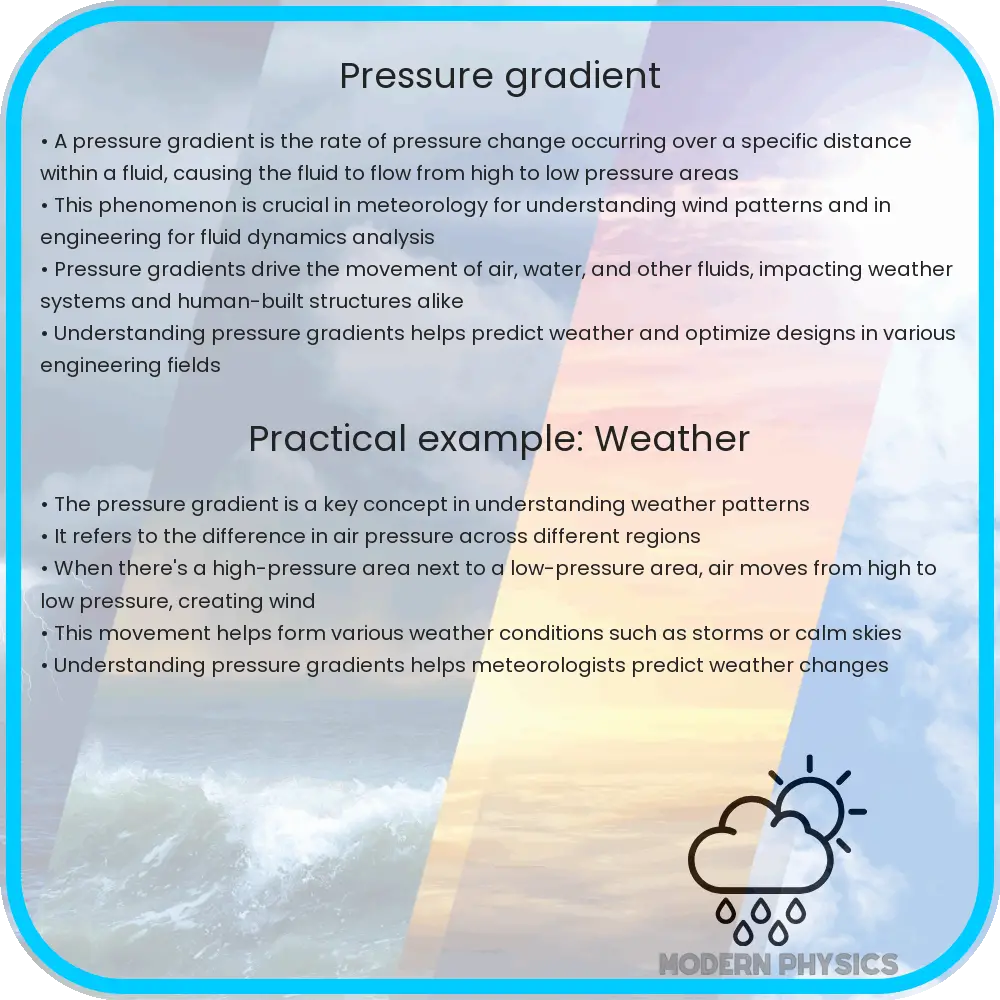Learn about pressure gradients, a key concept in fluid dynamics and oceanography that describes how pressure changes over distance, influencing fluid movement and ocean currents.

Understanding Pressure Gradients
Pressure gradient is a fundamental concept in both fluid dynamics and oceanography that describes the rate of change in pressure across a certain distance. Simply put, it’s a measure of how fast the pressure increases or decreases as you move from one point to another. This concept is crucial in explaining how fluids (both gases and liquids) move and behave in different environments.
Pressure Gradient in Fluid Flow
In the realm of fluid dynamics, the pressure gradient plays a pivotal role in determining the motion of fluids. According to the principles of physics, fluids always move from areas of high pressure to areas of low pressure. This movement is propelled by the pressure gradient force which acts perpendicular to isobars (lines of equal pressure) and in the direction of decreasing pressure.
The mathematical representation of the pressure gradient force (Fp) can be expressed as:
- Fp = -∇P
where ∇P denotes the pressure gradient vector, and the negative sign indicates that the force is directed from higher to lower pressure.
This force is a crucial factor in the equations governing fluid motion, notably in the Navier-Stokes equations, which describe the motion of viscous fluid substances. For a static fluid, the Navier-Stokes equation simplifies to the equilibrium state where the pressure gradient force is exactly balanced by the gravitational force, leading to hydrostatic balance.
Role of Pressure Gradients in Oceanography
In oceanography, pressure gradients are pivotal in understanding ocean currents and the overall circulation of ocean waters. Different heating patterns on the Earth’s surface and the varying salinity of water masses cause differences in water density, which in turn leads to differences in water pressure. These pressure differences create pressure gradients that drive the major ocean currents, such as the Gulf Stream in the North Atlantic and the Kuroshio in the Pacific.
The effect of pressure gradients in the ocean is also influenced by the Coriolis effect, resulting from the Earth’s rotation. The interplay between the pressure gradient force and the Coriolis effect generates geostrophic currents. These are currents that flow along the isobars where the pressure gradient force is balanced by the Coriolis force.
- Geostrophic Balance Equation: Fp + Fc = 0
where Fc represents the Coriolis force.
Understanding Pressure Gradients in the Atmosphere
Pressure gradients are not only crucial in the study of fluid dynamics and oceanography but also play a significant role in meteorology. Atmospheric pressure gradients drive the wind patterns that we experience on the Earth’s surface. Similar to ocean currents, winds generally move from regions of high pressure (anticyclones) to areas of low pressure (cyclones), influenced by both the pressure gradient force and the Coriolis effect.
The strength of the wind is directly related to the steepness of the pressure gradient; a steeper gradient results in faster winds. Monitoring these gradients allows meteorologists to predict weather patterns more accurately, including the movement of storm systems and the potential for severe weather events.
Practical Applications of Pressure Gradients
Understanding and manipulating pressure gradients have practical applications in various engineering fields. For instance, in the field of aerospace engineering, engineers design the shapes of airplanes to manage pressure gradients that contribute to lift and drag. Proper management of these gradients enables the creation of efficient and safe aircraft designs.
In mechanical engineering, pressure gradients are essential in the design of pumps and turbines. By controlling the pressure differences across these devices, engineers can maximize efficiency and power output. Additionally, in the medical field, pressure gradients are fundamental to numerous diagnostic techniques, such as measuring blood pressure to assess cardiovascular health.
Conclusion
Pressure gradients serve as a fundamental concept that permeates through various scientific and engineering disciplines. From driving the majestic movements of ocean currents and atmospheric winds to playing critical roles in the design of cutting-edge technology, understanding pressure gradients allows us to harness and predict the natural and engineered world more effectively. Whether it’s aiding in the navigation of ships based on ocean currents or the flight of aircraft, the implications of pressure gradients are vast and deeply integrated into our lives. By studying these forces, scientists and engineers continue to develop better systems and technologies that improve our understanding of nature and enhance our capabilities in technology-driven fields.
